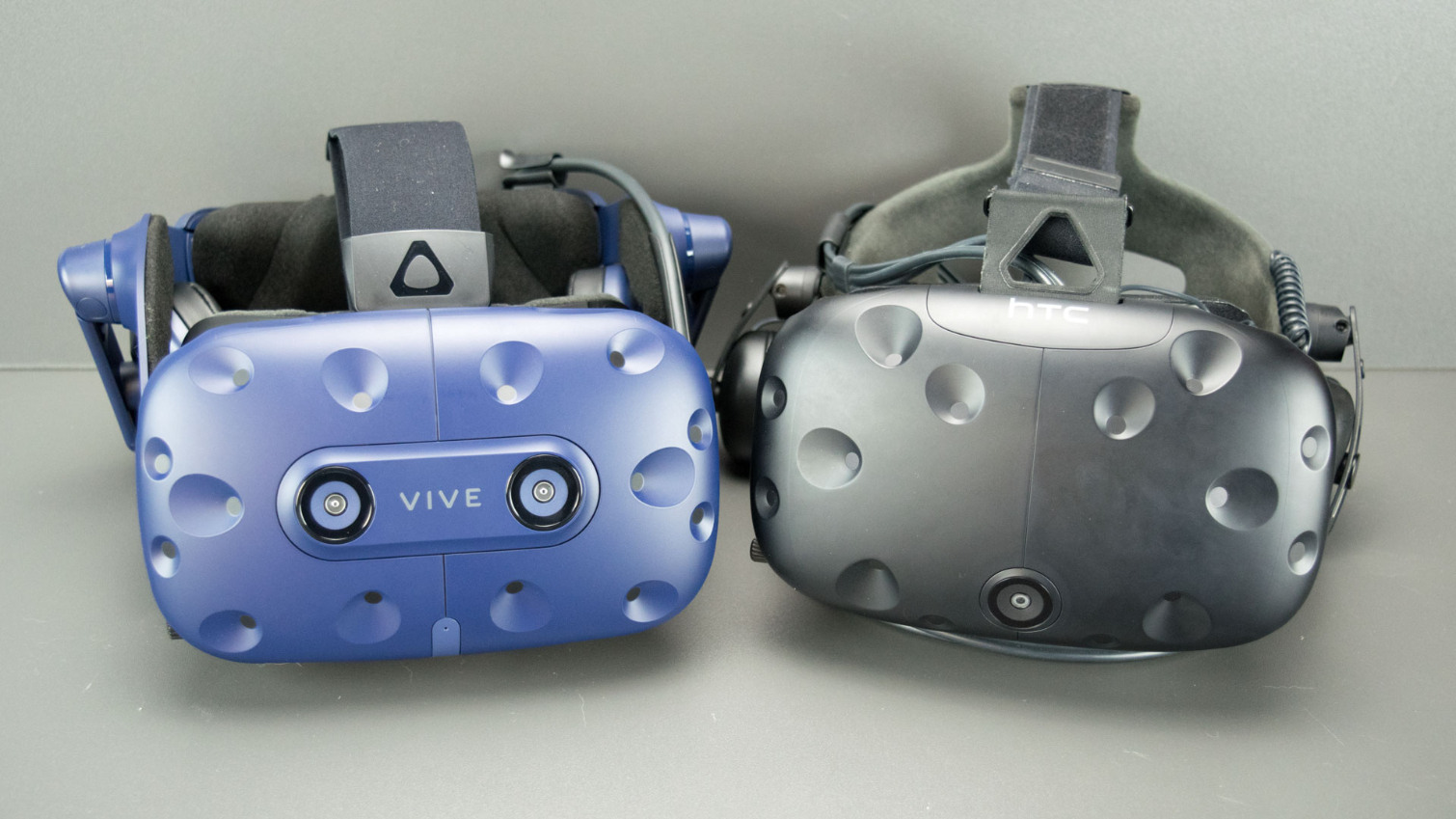HTC Vive Pro Headset Review: A High Bar for Premium VR
Why you can trust Tom's Hardware
How We Tested the HTC Vive Pro
If you’ve read our review of the Samsung Odyssey Windows Mixed Reality headset, you should already be familiar with the evaluation process that we used for the Vive Pro headset. Conveniently, we were just wrapping up our tests with the Samsung headset when HTC dropped the Vive Pro on our doorstep. We ran the Vive Pro through the same group of games, with the same graphics settings, on the same test machine, and with the same graphics drivers as we did with the Odyssey headset.
Our VR performance analysis suite consists a handful of games with varying visual fidelity, including Rick & Morty: Virtual Rick-ality, Gorn, Arizona Sunshine, Serious Sam VR: The Last Hope, and Island 359. Gorn, Rick & Morty, and Arizona Sunshine are all based on the Unity 3D engine. Gorn and Rick & Morty have basic graphics profiles, which don’t exactly push the limits of modern powerful graphics cards. Arizona Sunshine is a much more demanding title, though the CPU takes the brunt of the hit in that game.
Croteam’s Serious Sam VR, which is built on Croteam’s proprietary Serious Engine, provides a heavier load for the GPU to crunch through. And Cloudgate Studio’s Island 359, which is built on Unreal Engine, puts heavy stress on our graphics system. In fact, it’s the only game in our suite that consistently pushes our test rig beyond its limits.
Test Hardware
Our VR test system features an Intel Core i7-5930K, 16GB of Crucial Balistix Sport DDR4 2133, and an MSI X99S Xpower motherboard. We tested each HMD with a Gigabyte GTX 980 Ti Xtreme Gaming card, as well as an EVGA GTX 970 SC.
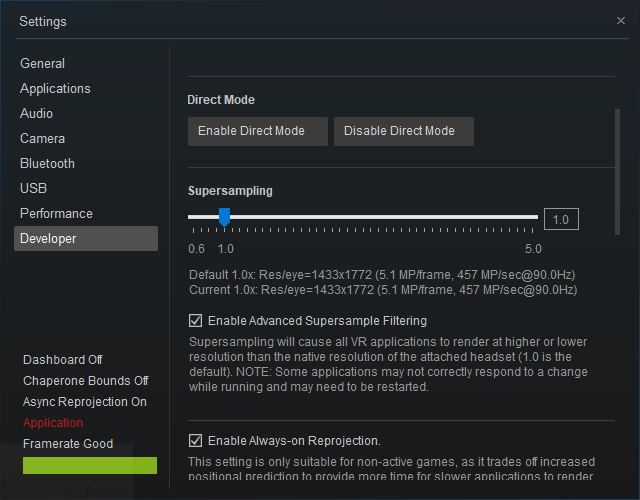
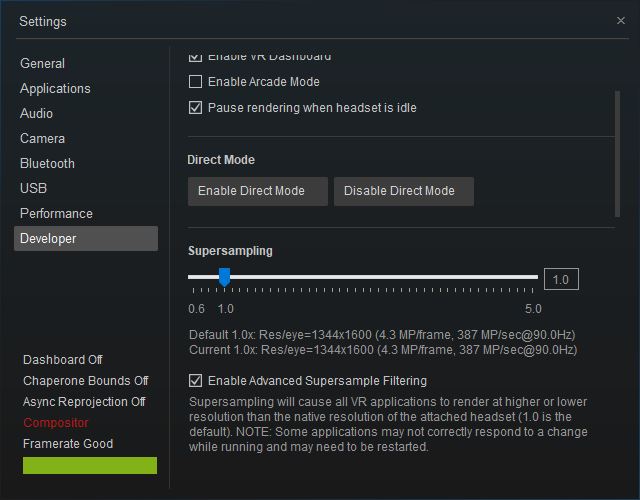
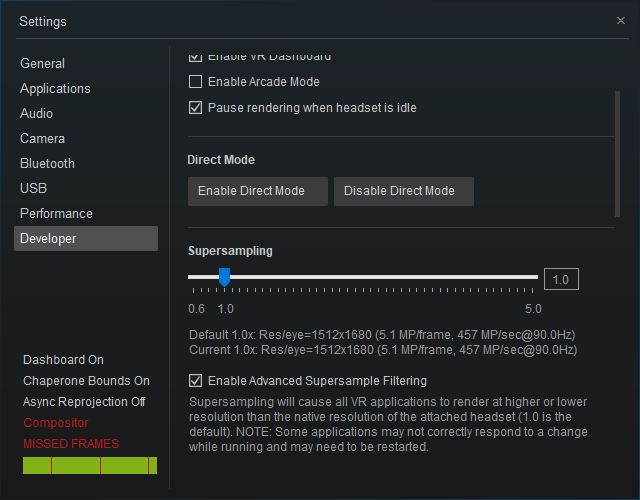
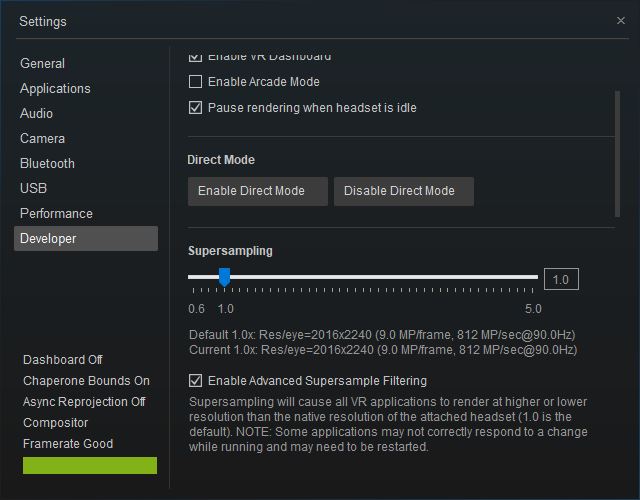
As we discussed in the Odyssey review, SteamVR has a feature called the Rendering Target, which dictates the rendering resolution independent of the display panels in the headset. For the HTC Vive, which features 2,160x1,200 resolution, SteamVR pushes 1,512x1,680 pixels, which equates to 5.1 megapixels per frame. SteamVR gives the Oculus Rift a slightly lighter workload for the same display resolution. The Rift receives a 1,344x1,600-pixel signal, which works out to 4.3 megapixels per frame.
During our evaluation of the Samsung Odyssey, we discovered that, despite the higher-resolution 2,880x1,600 display, SteamVR wasn’t sending a higher-resolution image to the Odyssey headset compared to the Vive. SteamVR’s default rendering target for the Odyssey is 1,433x1,772 pixels, which works out to 5.1 megapixels, like the signal destined for the Vive.
With the Vive Pro, SteamVR kicks the rendering target up a lot. HTC boasts that the Vive Pro’s display resolution is 78% higher than the original Vive's. Consider that SteamVR’s rendering target is a full 77% higher resolution than the panels in the headset. SteamVR delivers a 2,016x2,240 pixel signal to HTC's new HMD, which works out to 9 megapixels per frame. As a result, the Vive Pro’s default SteamVR configuration offers even better image clarity than that of the Odyssey headset, despite the two headsets using the same panels.
Get Tom's Hardware's best news and in-depth reviews, straight to your inbox.
But this level of image fidelity comes with a heavy price. The Vive Pro demands a much stronger graphics subsystem to drive the display. The original Vive HMD required a GeForce GTX 970 or a Radeon R9 290/390 (or better) to drive the HMD at 90Hz in all experiences. To power the new headset, you’ll want something a little more powerful. HTC said the new HMD is compatible with all VR-ready GPUs, but a GeForce GTX 1070 or a Radeon RX Vega 54 (or better) is strongly recommended.
| System Requirements | HTC Vive Pro |
| Processor | Intel Core i5-4590 or AMD FX 8350, equivalent or better |
| Minimum Graphics | Nvidia GeForce GTX 1060 or AMD Radeon RX 480, equivalent or better |
| Recommended Graphics | Nvidia GeForce GTX 1070/Quadro P5000 or above, or AMD Radeon Vega 56 or above |
| Memory | 4GB RAM or more |
| Video out | DisplayPort 1.2 or newer |
| USB ports | 1x USB 3.0 or newer port |
| Operating system | Windows 8.1 or later, Windows 10 |
Performance Tests
We used Nvidia’s FCAT VR performance-analysis tool to capture the frame-rate and frame-timing data our of game tests. The version that we’re using is an unreleased beta provided by Nvidia.
For each game, we captured 60 seconds of gameplay with each HMD and each graphics card. VR games aren’t really conducive to repeating precise movements, but to the best of our ability, we tried to replicate each run as closely as possible.
We used the data from our Samsung Odyssey review for comparison numbers instead of running new tests. Because of the significant difference in SteamVR’s default rendering target for the Vive Pro and the Samsung Odyssey, we also reran our tests with Samsung’s headset with SteamVR’s rendering target set to 1.8x, which works out to 1,923x2,377 pixels per eye, or the equivalent of 9.1 megapixels per frame. We didn’t test the GTX 970 with the 9.1-megapixel render target but instead stuck to the standard 5.1 megapixels for the Odyssey headset, as the GTX 970 isn't up to the task of pushing most games at such high resolutions.
Current page: How We Tested the HTC Vive Pro
Prev Page More Than a Resolution Upgrade Next Page HTC Vive Pro Performance AnalysisKevin Carbotte is a contributing writer for Tom's Hardware who primarily covers VR and AR hardware. He has been writing for us for more than four years.
-
ingtar33 well glad the screen door effect is discussed, somehow that's left out of many of these VR display discussions, as anyone who's actually used one for 5 minutes will tell you it's the biggest problem you'll face in VR for the most part.Reply
Good news on the design improvements and resolution improvement. Shame that god rays are still an issue. Seems like we're still a generation or two on this tech before it becomes something viable for the mainstream. -
jfkeenan There are several VR solutions available at a variety of price points. I wish people would stop complaining that HTC is offering a premium product. When I learned the news of the pre-order I was like, "Shut up and take my money!" I just got my tax return so this was a no brainer for me. Like Kevin said, if you can't afford a Mercedes don't be mad at them for making luxury cars.Reply -
kcarbotte Reply20852498 said:well glad the screen door effect is discussed, somehow that's left out of many of these VR display discussions, as anyone who's actually used one for 5 minutes will tell you it's the biggest problem you'll face in VR for the most part.
Good news on the design improvements and resolution improvement. Shame that god rays are still an issue. Seems like we're still a generation or two on this tech before it becomes something viable for the mainstream.
It's really not a big problem unless you're trying to do things that require reading text.
As someone who's put hundreds of hours in with the Vive, I can honestly say that screen door effect is not a real problem. It's just something that people like to complain about to give them justification not to adopt VR.
I won't deny that it exists. But I don't buy for a second that it's a real hindrance.
That said, if that's the biggest problem that you perceive, then VR is doing pretty good, I'd say. -
FreyjasChosen I'm with you, JFKEENAN. I pre-ordered the day it was available. I even bought the original HTC Vive because I needed the base stations and controllers (before the bundle was announced).Reply
I see a lot of complaints about the price tag of the Vive Pro, but no one's forcing anyone to buy it. I'm happy to pay for the best available product on the market. -
Giroro If HTC wants to charge a premium, then the device has to BE premium. There is a definite difference between "legitimately expensive" and "overpriced".Reply
At the end of the day, the Vive pro is still a tethered plastic headset that uses an inferior Samsung pentile display (forcing your system to waste 30% of its resources rendering subpixels that don't actually exists). Is the design a little better thought-out? sure.. that's how product iteration works. You change the design over time to improve quality and to decrease cost. What has HTC actually done here to justify the fact that they've more than doubled their asking price?
At the end of the day, nobody is going to pay "Lamborghini" prices for a Nissan Leaf E; not even one with particularly nice paint comfortable seats.
Of course, that's not a perfect analogy, because a used Nissan leaf is probably less expensive than a Vive Pro if you add in a computer powerful enough to deliver 90fps to such an impractical display. -
uglyduckling81 Kcarbotte can I ask which titles you have put the most time into?Reply
I've had a vive since launch but have used it less than 30 hours. I haven't found a game to put a lot of hours into. -
rhysiam The issue with your luxury car analogy is that in the case of VR, the product needs a vibrant software market to really succeed long term. When you buy a luxury car you're able to use a well-established road system that's developed over many years. That's not the case with VR. We have a classic chicken-and-egg situation where software developers are understandably nervous about investing heavily in VR experiences because the price of entry for VR results in a tiny potential market for their VR game/experience, while on the flip side, sales of headsets are being impacted by the limited games and experiences on offer. Lower headset sales means poorer economies of scale and higher per-headset prices to recoup the huge R&D investments, which just exacerbates the issue.Reply
Those of us (myself included) who really want VR to thrive long term do IMHO have some cause for concern with products like the Vive Pro that reinforce the fringe nature of VR and don't do a lot to entice the all-important software developers into the ecosystem.
Another threat to VR, and perhaps a bigger threat at that, is race-to-the-bottom headsets which compromise the experience. I know several people who have tried cheap, flawed VR experiences and written off VR as a whole. At least Vive is clearly marketing - and making strides to provide - a genuinely good VR experience.
I'm genuinely hoping for the day when I can pop on a wireless headset with 4K (or more) per eye and well-implemented foveated rendering and explore foreign worlds with interesting characters and complex stories. That's a platform that I would be more than willing to pay a lot of money to get access to. But getting there will require significant investment both on the hardware and software side. The Vive Pro headset is absolutely a step in the right direction from a technical hardware perspective, but is an (effectively) $1100 product right for the VR industry as a whole in the long term? I'm not so sure. -
uglyduckling81 I would say yes.Reply
Like you said a bad VR experience is horrendous and immediately turns you away.
When I got the Vive I only had a GTX 970 and it made me very sick every time I tried to use it. I was on the verge of selling it and putting VR into the non compatible with me section.
I took a different approach and upgraded to a GTX 1080 and haven't gotten sick since.
Turns out my hopeless travel sickness body is extremely susceptible to any frame time issues and the extra GPU horsepower did the trick. -
Ionlydothis The problem isn't that about offering a premium product. It's just that the Vive Pro IS NOT premium. It's exploitative. Minor improvements for a huge mark up but still the same critical flaws? Yeah, no thanks!Reply -
svx94 You can position yourself like Rolex or Mercedes of luxury market, they are built for "EXCLUSIVENESS"... that magic word won't do you any good in gaming market.Reply
